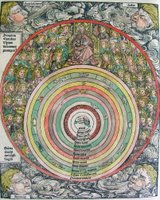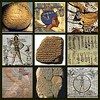Astrology To Astronomy And The Gods In Between

Superstition is to religion what astrology is to astronomy—the mad daughter of a wise mother. These daughters have too long dominated the earth." Voltaire
- 32 500 BCE - 38 000 BCE: GERMANY: An ivory tablet has been interpreted as having a pattern of the same stars that we see in the sky today in the constellation Orion.
- 30 000 BCE: Bone carvings keep track of phases of Moon. Early people engraved patterns of lines on animal bones to keep track of the phases of the Moon.
- 16 500 BCE: FRANCE: A painted map of the prehistoric cosmos is on the wall of a famous Ice Age cave at Lascaux in central France. It has been suggested that it is a map of three particular stars: — Vega, Deneb and Altair. Astronomers today refer to it as the Summer Triangle. Those stars are among the brightest objects in the sky during the middle of a northern summer. The eyes of the bull, bird-man and bird could represent Vega, Deneb and Altair.
- 16 500 BCE: FRANCE: A map that looks like the Pleiades star cluster also has been spotted among the Lascaux frescoes.
- 4800 BCE: EGYPT: First evidence of astrological calendar stones near the Egypt-Sudan border.
- 4500 BCE: FRANCE: Megalithic stone structures built at Carnac. These may have been astronomical in nature.
- 4242 BCE: EGYPT: Earliest recorded date in history. Egyptian calendar which is regulated by Sun and Moon has 360 days with 12 months of 30 days.
- 4236 BCE: EGYPT: Egyptians institute the 365 day calendar.
- 4000 BCE: MESOPOTAMIA: Astrology begins in Mesopotamia. Sumerians build ziggurats, the first astrological observatories. The Sun, Moon and 5 visible planets are used. Astrological knowledge is recorded in cuneiform on clay tablets. (Mesopotamia does not refer to any particular civilization. Over the course of several millennia, many civilizations developed, collapsed, and were replaced in this region including the Sumerians -- Akkadians -- Babylonians and Assyrians.)
- 4000 BCE: MESOPOTAMIA: The Sumerians, who settled in Mesopotamia around 4000 BC, mark the first example of a people who worshipped the sun, moon, and Venus. They considered these heavenly bodies gods, or the homes of gods. The moon god’s name was Nanna, the sun god was called Utu, and the god of Venus was named Inanna.
- 3000 BCE: ENGLAND: The main stones of Stonehenge are put into place. 3000 BCE: EGYPT: The earliest evidence of sun and moon worship in Egypt.
- 3000 BCE: SCOTLAND: Construction of a megalithic astronomical structure at Callanish, Isle of Lewis.
- 3000 BCE: IRELAND: This Neolithic carving is known as kerbstone 51. It is located around the cairn of Dowth in Ireland. It is significant as an astronomical stone as it contains what appear to be suns, or stars, with rays coming out from the centre, and with the whole surrounded by a circle. There are seven of these suns in total, six of which are contained within circles.
- 2680 BCE: EGYPT: Estimated completion date of the Egyptian Great Pyramid - opinion is divided as to its astronomical significance.
- 2575 BCE - 2467 BCE: EGYPT: King Khufu's Great Pyramid of Giza was built. People prayed to the sun god Re. The first religious words were written on the walls of the royal tombs.
- 2500 BCE: ENGLAND: Building of Stonehenge. The building of Stonehenge took place over many centuries. Alignments of the stones at Stonehenge mark the rising and setting points of the Sun at the solstices.
- 2494 BCE - 2345 BCE: EGYPT: During the 5th Egyptian Dynasty, worship of the sun god Ra becomes the predominant religion.
- 2350 BCE: EGYPT: En Hedu'anna, an Egyptian priestess, may be the first female astronomer and scientist ever recorded. She traced the history and progressions of the Moon and stars.
- 2300 BCE: CHINA: Chinese astronomers start to observe the sky, and in 2296BC, a comet is observed for the first time.
- 2138 BCE: MESOPOTAMIA: A solar eclipse on 9 May and a lunar eclipse on 24 May occurred and are believed to be the double eclipse that took place 23 years after the ascension of King Shulgi of Babylon.
- 2000 BCE: EGYPT: Temple of Amen-Ra at Karnak. The Temple of Amen-Ra at Karnak, Egypt was built so that its main axis points to the sunset at the summer solstice.
- 2000 BCE: MESOPOTAMIA: Lunar eclipse observed at Ur in Mesopotamia. The oldest known recording of a lunar eclipse took place at Ur more than 4000 years ago.
- 2000 BCE: MESOPOTAMIA: The Babylonians and their Sumerian ancestors had a well-developed knowledge of astronomy by 2000 BC. Evidence points to the Babylonians and Sumerians as the originators of our constellation system.
- 1900 BCE: MESOPOTAMIA: Epic of Gilgamesh in Mesopotamia.
- 1800 BCE - 1530 BCE: MESOPOTAMIA: The Amorites imported a new god into Sumerian religion, Marduk, which they elevated to the supreme position over the other gods. Like the Sumerians, the Amorites did not believe that life after death held any promise or threat, so like the Sumerians, Amorite religion focussed on this world.
- 1750 BCE: The Babylonians solve linear and quadratic algebraic equations, compile tables of square and cube roots. They use Pythagoras's theorem and use mathematics to extend knowledge of astronomy.
- 1700 BCE - 1681 BCE: Like the Chinese, Babylonian astrologers kept careful records about celestial happenings including the motions of Mercury, Venus, the Sun, and the Moon on tablets. 1600 BCE: MESOPOTAMIA: Chaldean astronomers identify and establish the zodiac.
- 1700 BCE: CRETE: The Phaistos Disk is a curious archaeological find, most likely dating from about 1700 BC. One of the theories is that it is an ancient calendar system perhaps used for agriculture.
- 1600 BCE: GERMANY: The Nebra disk, a 12-inch bronze and gold disk from this time, was evidence of ancient German astronomy. It recorded images of the sun, moon and 32 stars.
- 1550 BCE: EGYPT: The Opet Festival celebrated the Theban triad of the sun and creator Amun, his consort Mut, and their son Khonsu.
- 1500 BCE: INDIA: Aryans worship Moon god Varuna.
- 1500 BCE: - 1000 BCE: INDIA: To the Indians, the sun was the ancient ancestor of the human race and the distributor of wealth. The sun god's iconographic aspects were established by the Vedic period and several are depicted in a stela of the god in human form.
- 1470 BCE: EGYPT: The 97-foot obelisk at Karnak, Egypt, was erected as part of a sun dial and cast its shadow on a temple of the sun god Amun Ra.
- 1400 BCE: MESOPOTAMIA: The roots of Mithraic belief are found in the worship of the Sky Goddess Mitra in northern Mesopotamia.
- 1400 BCE: MESOPOTAMIA: Avesta of Zarathustrians composed in Avestan, an East-Iranian Language.
- 1391 BCE -1358 BCE: Amenhotep IV changes name to Akhenaten and tries to institute a monotheistic religion by worshipping only the sun-disk god Aten. He also said that he was the only one who could speak with Aton, so there was no need for priests. He even changed his name to Akhenaton, which means “servant of the Aton.” He banned the worship of Amon and closed down that god’s sacred temples. In the sixth year of his rule Akhenaton, along with his wife, the beautiful Nefertiti, moved out of the capital city of Thebes to a new capital in Middle Egypt named Akhetaton - “The Horizon of Aton” which is modern Amarna. (Amarna Tablets)
- 1375 BC. MESOPOTAMIA: Babylonian clay tablets that have survived since dawn of civilization in the Mesopotamian region record the earliest total solar eclipse seen in Ugarit on May 3, 1375 BC.
- 1334 BCE - 1325 BCE: EGYPT: Tutankhamen invents device to chart star positions. Tutankamun was not given this name at birth, but rather Tutankhaten (meaning "Living Image of the Aten) following Akhenaten, who was most likely his father. He changed his name in the second year of his rule to Tutankhamun (or heqa-iunu-shema, which means "Living Image of Amun, Ruler of Upper Egyptian Heliopolis", which is actually a reference to Karnak).
- 1300 BCE: DENMARK: The "Chariot of the Sun," a representation of a horse pulling a gilded bronze disk on a cart, is made and deposited in a bog in Denmark. The disk, almost certainly a solar symbol, is taken as evidence of contemporary sun worship. Disks, perhaps with similar connotations, are also incorporated into attire. Women's graves, for example, sometimes include large belt adornments decorated with spiral designs carefully fitted inside concentric circles.
- 1300 BCE: CHINA: Chinese begin centuries long series of observation of eclipses. Chinese astronomers recorded 900 solar and 600 lunar eclipses over a period of 2600 years.
- 1200 BCE: GREECE: The Greeks named many of the constellations and four "wandering stars" (planets) after their gods: Mercury, Venus, Mars and Jupiter. The cosmological idea of naming the constellations was appropriated from the Greek's neighbors the Babylonians and Sumerians. Upon the Greeks "borrowing" the constellations (and utilizing a few of the same figures and symbols) - they, then, went about devising many of their own unique names and explanations as to how all the different animals and people had gotten into the sky. The ancient Greeks originally gave us 48 "classical" constellations.
- 1170 BCE - 612 BCE: MESOPOTAMIA: The last great monarch of Assyria was Ashurbanipal (668-626 BC), who not only extended the empire, but also began a project of assembling a library of tablets of all the literature of Mesopotamia. Thirty thousand tablets still remain of Ashurbanipal's great library in the city of Nineveh; these tablets are our single greatest source of knowledge of Mesopotamian culture, myth, and literature.
- 1000 BCE - 800 BCE: ITALY: The Vestini tribe put the stones of Fossa in place. Some think that this alignment might have been both astronomical and religious. These ancient people would have seen the Sun cycle over and over again, with the Sun rising in the East and setting in the West. If these people believed in a sort of after life or reincarnation they would have hoped for a similar cycling of human soul as they buried people here. And so we see that these people might have related their culture and religion to the movements of the Sun in the sky.
- 1100 BCE: EGYPT: Amenhope created a catalogue of the universe in which only five constellations were recognized. They also listed 36 groups of stars called decans.
- 800 BCE: CHINA: First recorded sunspot observation, noted by Chinese in their "Book of Changes."
- 763 BCE: Babylonians observe and record another Solar eclipse.
- 750 BCE - 400 BCE: Astronomical observation and record-keeping by New Babylonians.
- 700 BCE: Babylonians predict lunar eclipses from this time. The Babylonians used their long record of eclipses to see regular patterns of eclipses. They used these patterns to predict lunar eclipses.
- 700 BCE: The Babylonians had a well-established system of constellations of the zodiac, the strip of sky traversed by the Sun, Moon and planets. We know this from a star list written in cuneiform on a clay tablet dated to 687 BC. Scholars call this list the MUL.APIN series, from the first name recorded on the tablet. The Babylonian constellations had many similarities with those we know today, but they are not all identical. From other texts, historians have established that the constellations known to the Babylonians actually originated much earlier, with their ancestors the Sumerians before 2000 BC.
- 650 BCE: ASSYRIA: Royal Library established by Ashurbanpial at Nineveh, including an estimated 20,000 cuneiform tablets.
- 648 BCE - 330 BCE: The first PERSIAN STATE: Achaemenid Persia: Around 650 BC, a new religion took hold. The man who invented this new religion was called Zarathustra (Zoroaster in Greek). His new religion and new gods captivated the spiritual and social imagination of the Persians. Zoroastrianism is a dualistic religion; in Zarathustra's cosmos, the universe was under the control of two contrary gods, Ahura-Mazda, the creating god who is full of light and good, and Ahriman, the god of dark and evil. These two evenly matched gods are in an epic struggle over creation; at the end of time, Ahura-Mazda and his forces will emerge victorious. All of creation, all gods, all religions, and all of human history and experience can be understood as part of this struggle between light and dark, good and evil.
- 610 BCE: GREECE: Birth of Anaximander, a later pupil of Thales and one of the principal instigators of astronomy in ancient Greece
- 600 BCE: INDIA: First astronomy texts written in India.
- 585 BCE - 575BCE: GREECE: Thales said to have predicted solar eclipse. The eclipse took place during a battle between the Lydians and the Persians. They were so stunned by the eclipse they ended the battle. Thales brings Babylonian mathematical knowledge to Greece. He uses geometry to solve problems such as calculating the height of pyramids and the distance of ships from the shore.
- 500 BCE: The Babylonian sexagesimal number system is used to record and predict the positions of the Sun, Moon and planets.
- 290 BCE: Aristarchus of Samos uses a geometric method to calculate the distance of the Sun and the Moon from Earth. He also proposes that the Earth orbits the Sun.
- 150 BCE: Hypsicles writes On the Ascension of Stars. In this work he is the first to divide the Zodiac into 360 degrees.
- 127 BCE: Hipparchus discovers the precession of the equinoxes and calculates the length of the year to within 6.5 minutes of the correct value. His astronomical work uses an early form of trigonometry.
(TO BE CONTINUED)




















